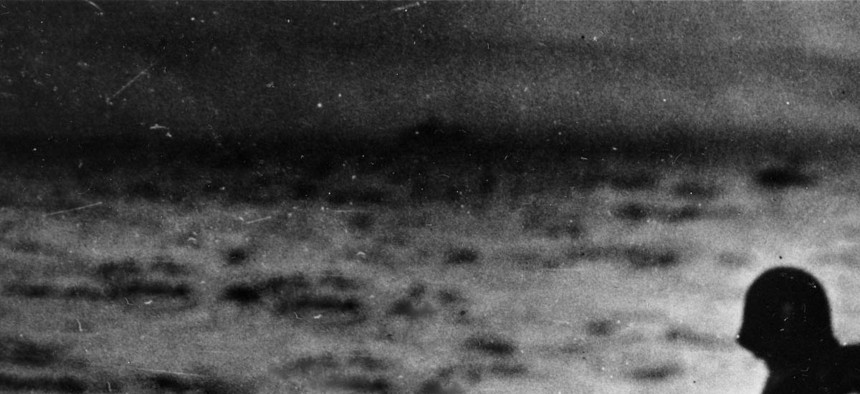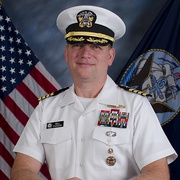
A Coast Guard landing barge packed with soldiers prepares to land at Normandy France on June 6, 1944. AP Photo
We Did It Before, But Could We Do It Again?
D-Day required a masterpiece of planning, leadership, and willingess to follow. Not that much has changed. By Capt. William J. Parker, III
As we honor the sacrifices of those who fought to liberate Europe seventy years ago today, we’re quick to remember names like “Normandy,” “D-Day,” “Overlord,” and “Utah Beach.” Today, Americans, Brits and Canadians will reach for one of the many books or movies depicting the largest amphibious landing in history. In the process, we will reflect on the heroics of the thousands who performed their duties so selflessly on June 6, 1944. We must also honor the deeds of those service members and civilians who worked so hard—and with such acute focus—in the years, months and days that preceded the actual invasion.
As history validates, the Normandy invasion was not a one-day event. The landing lasted twenty days, from June 6 to 25, and the preparations spanned several months leading up to the assault. Logisticians had to place men, machines, food and weapons in the right place at the right time. The planning process took still longer, occupying Allied strategists for years. Their most important decisions were the resolution to open a second front in Europe and their choice of leaders for what would become known as Operation Overlord.
By June of 1944, Hitler’s Germany was not yet a defeated nation. It was, however, occupied with its own attack on Russia, code-named Operation Barbarossa. Barbarossa was the largest land attack in the history of warfare. Beginning on June 22, 1941, nearly 4 million Axis soldiers attacked Russia across a front that stretched almost 2,000 miles. The Germans were about to experience a two-front war.
Two years before the invasion, in 1942, Franklin Roosevelt and Winston Churchill agreed that the two Western Allies would open a second front on the continent in order to relieve the pressure on Stalin. Their decision to invade the European continent, as well as their selection of General Dwight D. Eisenhower as the Supreme Commander of the Allied Expeditionary Force and Commander of all Allied Forces in Europe, proved to be both bold and brilliant.
Eisenhower’s West Point-trained wisdom extended well beyond the battlefield. He knew how to build international coalitions and he knew when to make a decision and when to adjust his plan if a better suggestion was presented. Eisenhower did not accept the British proposal to attack from the Mediterranean through Italy (south-to-north) and instead stuck with his original plan to conduct a cross-channel amphibious assault. This would give him a shorter route to Germany and increase his air cover thanks to the proximity of friendly airfields.
This plan was ultimately supported by Roosevelt and Churchill at the “Trident Conference” in Washington, DC on May 27. In an attempt to build a strong coalition team, with combat-proven success, Eisenhower appointed General Bernard Montgomery to command the invasion’s ground forces. Montgomery quickly assessed that Eisenhower’s original plan required several changes. Eisenhower approved these recommendations, which resulted in three airborne divisions preceding five landing divisions on D-Day. Eisenhower not only empowered Montgomery, but made the decision quickly enough to allow time for detailed planning, logistical moves, deception operations and rehearsals.
D-Day is really the story of many operations which culminated in one result. Although the Allied invasion of Europe and “Operation Overlord” are often conflated, there were actually four major operations, and a series of lesser operations that ultimately lead to the successful landing. Operation Overlord was the plan to establish a large-scale military presence on the European Continent. The Allied bombing campaign was codenamed Operation Pointblank. Operation Bodyguard was the overarching deception plan for the landing. Finally, Operation Neptune was focused on the initial amphibious landing that would establish the foothold on the beaches.
Operation Fortitude
The use of deception leading up to the invasion, in which Operation Fortitude was part of the larger Operation Bodyguard, was so effective that for most of the first day of the invasion, Hitler believed Normandy was still a feint and that the full force would land at Calais. While Normandy was still well-fortified, Allied deception operations led the Germans to consider it to be secondary in defensive priorities to larger ports with more hospitable beaches. The imaginary British 4th Army immobilized thirteen German divisions in Norway while General George Patton’s fictitious First United States Army Group held Germany’s 15th Army in standby in the vicinity of Pas de Calais. These well-executed deception operations resulted in the diffusion of German defensive fortifications along the coast and ultimately helped allow the Allies’ concentration of forces to overwhelm German defenders.
Operation Neptune
British Admiral Bertram Ramsay was appointed by Eisenhower to serve as the Commander-in-Chief of the Allied Naval Expeditionary Force for the invasion. Ramsay, like Eisenhower and Montgomery, had experienced command in the most dire conditions. Charged with the naval evacuation of Dunkirk, he was later assigned to defend the waters around Dover from a full-scale German invasion. On the early hours of June 6, after months of deceiving the enemy and ensuring the force was properly dispersed to counter aerial bombardment by the Germans, a 5,200 ship armada traveled the 100 miles that spanned the English Channel. Ramsay’s force of warships, auxiliaries and landing craft from Britain, Canada, the United States and the navies-in-exile of France, the Netherlands, Norway, Poland and Greece moved from their berths and proceeded to their rendezvous points.
At 5:50 that morning, 125 war ships unleashed a naval bombardment that included tens of thousands of rockets and large caliber gun ordnance. Throughout the day, in addition to avoiding U-boats and mines, the Allied naval force was under fire from long range shore batteries, heavy seas which would get considerably worse over the upcoming days, and more than 300 Luftwaffe attacks. Throughout the first day, the Allied navies operated more than 4,000 small boats to shuttle forces and equipment between ships and the beaches, suffering immense casualties. The first Americans landed on Utah Beach at 6:30 that morning and would continue to land men and supplies for the next two weeks. Altogether, the Allies would suffer 59 sunken ships and 120 more damaged during the invasion. Untold additional ships and craft were lost to violent seas on June 18 and 19.
D-Day’s Legacy
As we look back on Normandy, and reflect on our military today, what remains the same and what is different? Are we still capable of such a heroic undertaking? First, the soldiers, sailors, airman, marines and civilians currently serving today are just as brave and patriotic as their forefathers. Second, technology has changed on our ships, but so has the technology of our enemies. Third, numbers still matter. Eisenhower, as the warfare commander for that time in world history, knew how many ships were needed to successfully complete the invasion. Our combatant commanders today use the same type of analysis to determine the number and type of ships required to execute the Defense Strategic Guidance.
However, our strategies have changed. We have learned much from the lessons of war. MacArthur’s island-hopping campaign in the Pacific demonstrated that, when possible, avoiding a frontal assault is preferable to plowing ahead. Maneuvering inland with aircraft and other lift-capable assets is infinitely preferable to the sort of frontal amphibious assault we conducted on D-Day. But there will still be times when a conventional landing is necessary.
Finally, at the end of the day, despite all the technology—all the drones, stealth, technology, intelligence and satellite communications—warfighting remains a human endeavor. Going to war is about people. Hitler benefitted from amazing technology and had a highly experienced and expertly-led military, but his soldiers and people suffered as a result of his poor leadership. The Allied leaders, and the Allies’ willingness to do whatever was necessary to win, made the final difference. Of course, technology and capacity of the U.S war machine played a huge role in the Allied victory. But it was the people who ultimately made the difference.
Today, the roughly 25 percent of America’s youth who are eligible to enlist—those that are not too obese, using drugs, have arrest records or are unable to pass aptitude tests—collectively make up a superb pool for the military to draw from. Those who do join make up the best of America’s sons and daughters. They are part of the most selective All-Volunteer Force in our nation’s history. Comprising less than one half of one percent of the national population, most of them joined the military while the nation was at war.
Rest assured; they are as equal to the tasks that will be placed before them and the sacrifices demanded of them as their grandfathers were seventy years ago.
William J. Parker III is a U.S. Navy surface warfare officer who most recently commanded Destroyer Squadron Two Three. Captain Parker is a 1988 distinguished military graduate and class president of the U.S. Air Force Academy. He is an award winning author who holds a PhD in biological defense from George Mason University’s department of molecular and microbiology and an MA from Harvard University’s John F. Kennedy School of Government.
This post appears courtesy of CFR.org.




